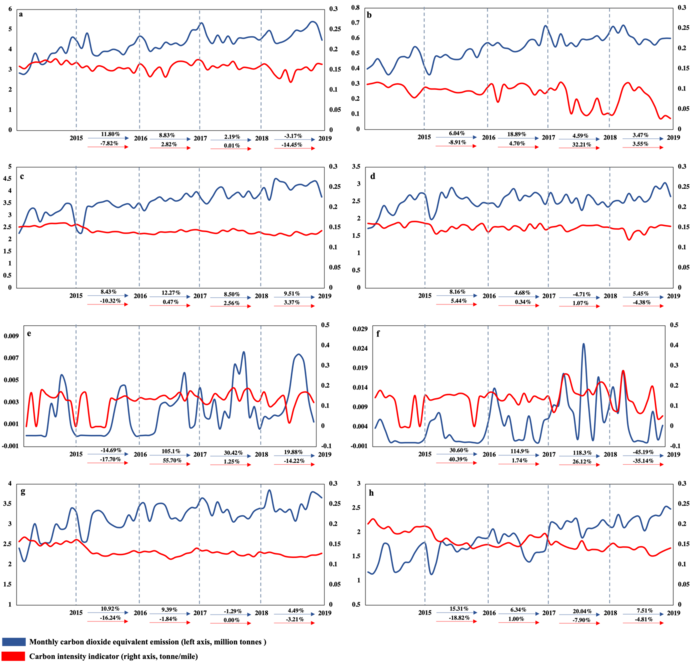Countries impose strict carbon emission regulations on shipping activities in their territorial seas or exclusive economic zones to satisfy the climate change commitments under the Paris Agreement. However, no shipping carbon mitigation policies for the high seas have been proposed because signatories are not immediately responsible for high seas carbon reduction under the Paris Agreement.
 (a)-(h) provides the monthly carbon dioxide equivalent emissions and energy efficiency operational indicator for North Pacific Ocean High Seas (a), South Pacific Ocean High Seas (b), North Atlantic Ocean High Seas (c), South Atlantic Ocean High Seas (d), Arctic Ocean High Seas (e), Southern Ocean High Seas (f), Indian Ocean High Seas (g), and Other High Seas (h). Image Credit: ©Science China Press
(a)-(h) provides the monthly carbon dioxide equivalent emissions and energy efficiency operational indicator for North Pacific Ocean High Seas (a), South Pacific Ocean High Seas (b), North Atlantic Ocean High Seas (c), South Atlantic Ocean High Seas (d), Arctic Ocean High Seas (e), Southern Ocean High Seas (f), Indian Ocean High Seas (g), and Other High Seas (h). Image Credit: ©Science China Press
The research was guided by Dr. Shouyang Wang from the Chinese Academy of Sciences’ Academy of Mathematics and Systems Science and Dr. Dabo Guan from Tsinghua University.
Given that the high seas account for more than two-thirds of the world ocean regions, the carbon intensive shipping activities on the high seas could become a potential barrier to the worldwide carbon mitigation and sustainability efforts.
Shouyang Wang, Academy of Mathematics and Systems Science, Chinese Academy of Sciences
Shouyang Wang, Dabo Guan, and colleagues used a geographic-based emission estimation model to monitor shipping GHG emission patterns in high sea regions. The yearly shipping carbon dioxide equivalent (CO2-e) emissions on the high seas are estimated to be 211.60 metric tons in 2019. This amount accounts for roughly one-third of all global shipping emissions and surpasses the annual GHG emission outputs of several mid-sized European countries, including Spain.
Considering the current trends in high seas shipping, researchers assessed that average emissions from high seas shipping activities are increasing at a rate of approximately 7.26% per year, far exceeding the global shipping emission growth rate of 2.23%. The researchers identified major emission drivers in each high seas and suggested the best policy to enforce in each region by feeding different scenarios into their model.
Researchers described the primary implementation policy in relation to the main shipping carbon emission driver derived from the model results for each high sea. They concluded that incorporating different carbon mitigation policies in each high seas represents a better way to change the current emission structure and limit future high seas shipping emissions.
According to the policy evaluation results, introducing customized carbon mitigation policies in different high seas regions could lower 25.46 million tons of CO2 equivalent emissions in the primary intervention stage and 54.36 million tons in the overall intervention stage, respectively.
The customized carbon mitigation policy applied during the primary stage results in the greatest percentage reduction in emissions in each of the high seas regions (an average of 46.84% of the total emission reduction). This implies that, when likened to other policies, it is the most effective one in cutting emissions in the specific region.
By identifying the key factors driving the emission patterns in different high seas regions and designing tailored carbon mitigation policies for each region accordingly, it allows international high seas shipping to contribute to the world trading and economic growth in a more environmentally-friendly manner.
Shouyang Wang, Academy of Mathematics and Systems Science, Chinese Academy of Sciences
Journal Reference:
Li, Y., et al. (2022) The climate impact of high seas shipping. National Science Review. doi.org/10.1093/nsr/nwac279.